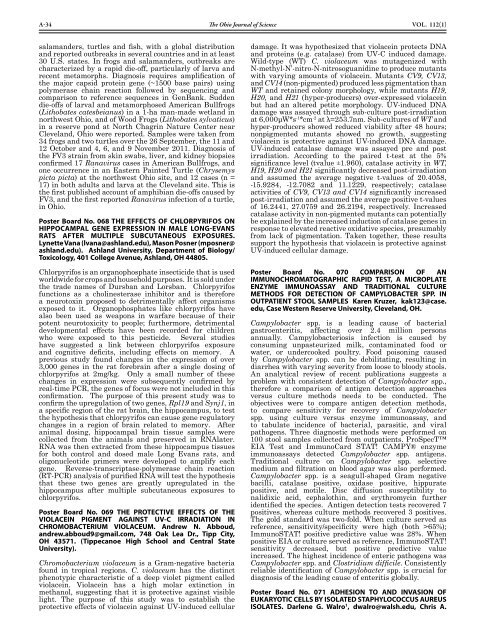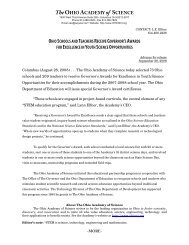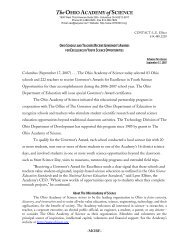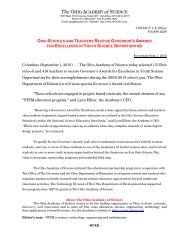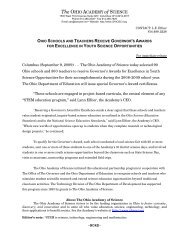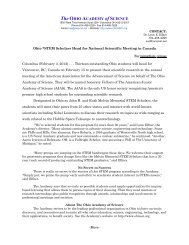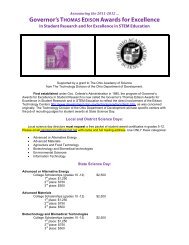The Ohio Journal of - The Ohio Academy of Science
The Ohio Journal of - The Ohio Academy of Science
The Ohio Journal of - The Ohio Academy of Science
You also want an ePaper? Increase the reach of your titles
YUMPU automatically turns print PDFs into web optimized ePapers that Google loves.
A-34 <strong>The</strong> <strong>Ohio</strong> <strong>Journal</strong> <strong>of</strong> <strong>Science</strong><br />
Vol. 112(1)<br />
salamanders, turtles and fish, with a global distribution<br />
and reported outbreaks in several countries and in at least<br />
30 U.S. states. In frogs and salamanders, outbreaks are<br />
characterized by a rapid die-<strong>of</strong>f, particularly <strong>of</strong> larva and<br />
recent metamorphs. Diagnosis requires amplification <strong>of</strong><br />
the major capsid protein gene (~1500 base pairs) using<br />
polymerase chain reaction followed by sequencing and<br />
comparison to reference sequences in GenBank. Sudden<br />
die-<strong>of</strong>fs <strong>of</strong> larval and metamorphosed American Bullfrogs<br />
(Lithobates catesbeianus) in a 1-ha man-made wetland in<br />
northwest <strong>Ohio</strong>, and <strong>of</strong> Wood Frogs (Lithobates sylvaticus)<br />
in a reserve pond at North Chagrin Nature Center near<br />
Cleveland, <strong>Ohio</strong> were reported. Samples were taken from<br />
34 frogs and two turtles over the 26 September, the 11 and<br />
12 October and 4, 6, and 9 November 2011. Diagnosis <strong>of</strong><br />
the FV3 strain from skin swabs, liver, and kidney biopsies<br />
confirmed 17 Ranavirus cases in American Bullfrogs, and<br />
one occurrence in an Eastern Painted Turtle (Chrysemys<br />
picta picta) at the northwest <strong>Ohio</strong> site, and 12 cases (n =<br />
17) in both adults and larva at the Cleveland site. This is<br />
the first published account <strong>of</strong> amphibian die-<strong>of</strong>fs caused by<br />
FV3, and the first reported Ranavirus infection <strong>of</strong> a turtle,<br />
in <strong>Ohio</strong>.<br />
Poster Board No. 068 THE EFFECTS OF CHLORPYRIFOS ON<br />
HIPPOCAMPAL GENE EXPRESSION IN MALE LONG-EVANS<br />
RATS AFTER MULTIPLE SUBCUTANEOUS EXPOSURES.<br />
Lynette Vana (lvana@ashland.edu), Mason Posner (mposner@<br />
ashland.edu). Ashland University, Department <strong>of</strong> Biology/<br />
Toxicology, 401 College Avenue, Ashland, OH 44805.<br />
Chlorpyrifos is an organophosphate insecticide that is used<br />
worldwide for crops and household purposes. It is sold under<br />
the trade names <strong>of</strong> Dursban and Lorsban. Chlorpyrifos<br />
functions as a cholinesterase inhibitor and is therefore<br />
a neurotoxin proposed to detrimentally affect organisms<br />
exposed to it. Organophosphates like chlorpyrifos have<br />
also been used as weapons in warfare because <strong>of</strong> their<br />
potent neurotoxicity to people; furthermore, detrimental<br />
developmental effects have been recorded for children<br />
who were exposed to this pesticide. Several studies<br />
have suggested a link between chlorpyrifos exposure<br />
and cognitive deficits, including effects on memory. A<br />
previous study found changes in the expression <strong>of</strong> over<br />
3,000 genes in the rat forebrain after a single dosing <strong>of</strong><br />
chlorpyrifos at 2mg/kg. Only a small number <strong>of</strong> these<br />
changes in expression were subsequently confirmed by<br />
real-time PCR, the genes <strong>of</strong> focus were not included in this<br />
confirmation. <strong>The</strong> purpose <strong>of</strong> this present study was to<br />
confirm the upregulation <strong>of</strong> two genes, Rpl19 and Synj1, in<br />
a specific region <strong>of</strong> the rat brain, the hippocampus, to test<br />
the hypothesis that chlorpyrifos can cause gene regulatory<br />
changes in a region <strong>of</strong> brain related to memory. After<br />
animal dosing, hippocampal brain tissue samples were<br />
collected from the animals and preserved in RNAlater.<br />
RNA was then extracted from these hippocampus tissues<br />
for both control and dosed male Long Evans rats, and<br />
oligonucleotide primers were developed to amplify each<br />
gene. Reverse-transcriptase-polymerase chain reaction<br />
(RT-PCR) analysis <strong>of</strong> purified RNA will test the hypothesis<br />
that these two genes are greatly upregulated in the<br />
hippocampus after multiple subcutaneous exposures to<br />
chlorpyrifos.<br />
Poster Board No. 069 THE PROTECTIVE EFFECTS OF THE<br />
VIOLACEIN PIGMENT AGAINST UV-C IRRADIATION IN<br />
CHROMOBACTERIUM VIOLACEUM. Andrew N. Abboud,<br />
andrew.abboud9@gmail.com, 748 Oak Lea Dr., Tipp City,<br />
OH 43571. (Tippecanoe High School and Central State<br />
University).<br />
Chromobacterium violaceum is a Gram-negative bacteria<br />
found in tropical regions. C. violaceum has the distinct<br />
phenotypic characteristic <strong>of</strong> a deep violet pigment called<br />
violacein. Violacein has a high molar extinction in<br />
methanol, suggesting that it is protective against visible<br />
light. <strong>The</strong> purpose <strong>of</strong> this study was to establish the<br />
protective effects <strong>of</strong> violacein against UV-induced cellular<br />
damage. It was hypothesized that violacein protects DNA<br />
and proteins (e.g. catalase) from UV-C induced damage.<br />
Wild-type (WT) C. violaceum was mutagenized with<br />
N-methyl-N’-nitro-N-nitrosoguanidine to produce mutants<br />
with varying amounts <strong>of</strong> violacein. Mutants CV9, CV13,<br />
and CV14 (non-pigmented) produced less pigmentation than<br />
WT and retained colony morphology, while mutants H19,<br />
H20, and H21 (hyper-producers) over-expressed violacein<br />
but had an altered petite morphology. UV-induced DNA<br />
damage was assayed through sub-culture post-irradiation<br />
at 6,000μW*s -1 *cm -2 at λ=253.7nm. Sub-cultures <strong>of</strong> WT and<br />
hyper-producers showed reduced viability after 48 hours;<br />
nonpigmented mutants showed no growth, suggesting<br />
violacein is protective against UV-induced DNA damage.<br />
UV-induced catalase damage was assayed pre and post<br />
irradiation. According to the paired t-test at the 5%<br />
significance level (tvalue ±1.960), catalase activity in WT,<br />
H19, H20 and H21 significantly decreased post-irradiation<br />
and assumed the average negative t-values <strong>of</strong> 20.4058,<br />
-15.9284, -12.7082 and 11.1229, respectively; catalase<br />
activities <strong>of</strong> CV9, CV13 and CV14 significantly increased<br />
post-irradiation and assumed the average positive t-values<br />
<strong>of</strong> 16.2441, 27.0759 and 26.2194, respectively. Increased<br />
catalase activity in non-pigmented mutants can potentially<br />
be explained by the increased induction <strong>of</strong> catalase genes in<br />
response to elevated reactive oxidative species, presumably<br />
from lack <strong>of</strong> pigmentation. Taken together, these results<br />
support the hypothesis that violacein is protective against<br />
UV-induced cellular damage.<br />
Poster Board No. 070 COMPARISON OF AN<br />
IMMUNOCHROMATOGRAPHIC RAPID TEST, A MICROPLATE<br />
ENzYME IMMUNOASSAY AND TRADITIONAL CULTURE<br />
METHODS FOR DETECTION OF CAMPYLOBACTER SPP. IN<br />
OUTPATIENT STOOL SAMPLES Karen Kruzer, kak123@case.<br />
edu, Case Western Reserve University, Cleveland, OH.<br />
Campylobacter spp. is a leading cause <strong>of</strong> bacterial<br />
gastroenteritis, affecting over 2.4 million persons<br />
annually. Campylobacteriosis infection is caused by<br />
consuming unpasteurized milk, contaminated food or<br />
water, or undercooked poultry. Food poisoning caused<br />
by Campylobacter spp. can be debilitating, resulting in<br />
diarrhea with varying severity from loose to bloody stools.<br />
An analytical review <strong>of</strong> recent publications suggests a<br />
problem with consistent detection <strong>of</strong> Campylobacter spp.,<br />
therefore a comparison <strong>of</strong> antigen detection approaches<br />
versus culture methods needs to be conducted. <strong>The</strong><br />
objectives were to compare antigen detection methods,<br />
to compare sensitivity for recovery <strong>of</strong> Campylobacter<br />
spp. using culture versus enzyme immunoassay, and<br />
to tabulate incidence <strong>of</strong> bacterial, parasitic, and viral<br />
pathogens. Three diagnostic methods were performed on<br />
100 stool samples collected from outpatients. ProSpecT<br />
EIA Test and ImmunoCard STAT! CAMPY® enzyme<br />
immunoassays detected Campylobacter spp. antigens.<br />
Traditional culture on Campylobacter spp. selective<br />
medium and filtration on blood agar was also performed.<br />
Campylobacter spp. is a seagull-shaped Gram negative<br />
bacilli, catalase positive, oxidase positive, hippurate<br />
positive, and motile. Disc diffusion susceptibility to<br />
nalidixic acid, cephalothin, and erythromycin further<br />
identified the species. Antigen detection tests recovered 7<br />
positives, whereas culture methods recovered 3 positives.<br />
<strong>The</strong> gold standard was two-fold. When culture served as<br />
reference, sensitivity/specificity were high (both >65%);<br />
ImmunoSTAT! positive predictive value was 28%. When<br />
positive EIA or culture served as reference, ImmunoSTAT!<br />
sensitivity decreased, but positive predictive value<br />
increased. <strong>The</strong> highest incidence <strong>of</strong> enteric pathogens was<br />
Campylobacter spp. and Clostridium difficile. Consistently<br />
reliable identification <strong>of</strong> Campylobacter spp. is crucial for<br />
diagnosis <strong>of</strong> the leading cause <strong>of</strong> enteritis globally.<br />
Poster Board No. 071 ADHESION TO AND INVASION OF<br />
EUKARYOTIC CELLS BY ISOLATED STAPHYLOCOCCUS AUREUS<br />
ISOLATES. Darlene G. Walro 1 , dwalro@walsh.edu, Chris A.


